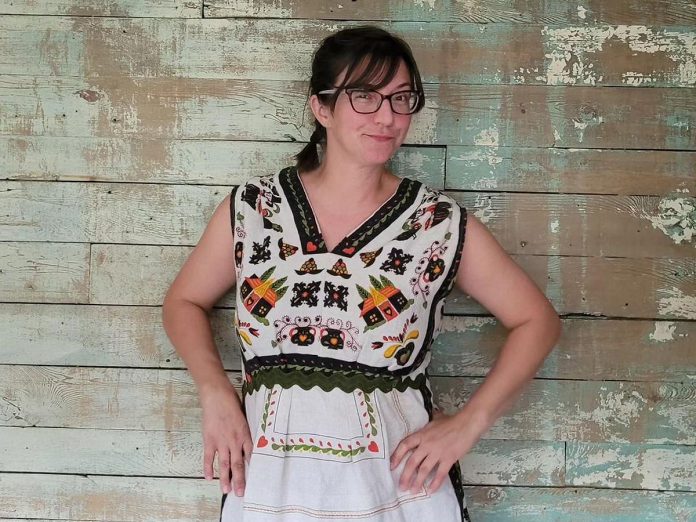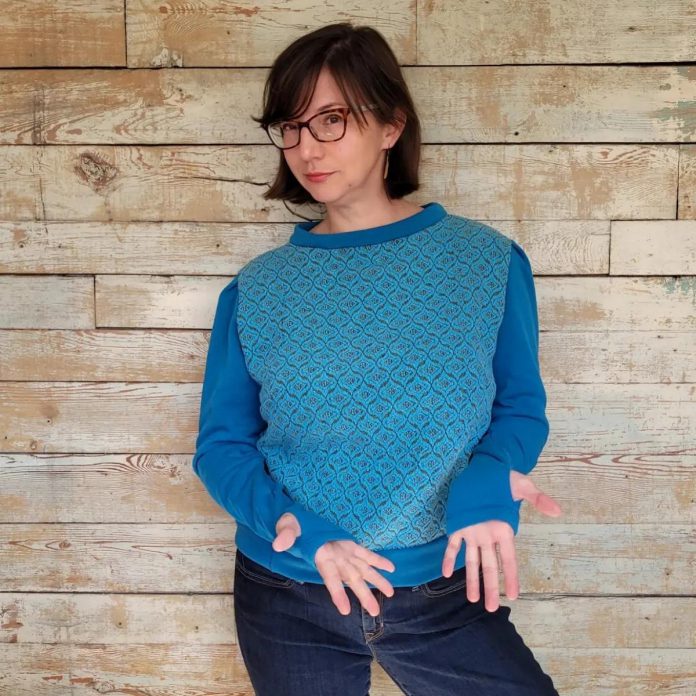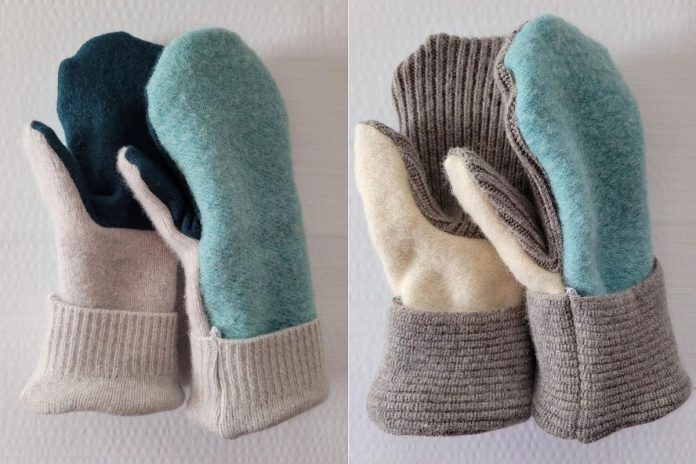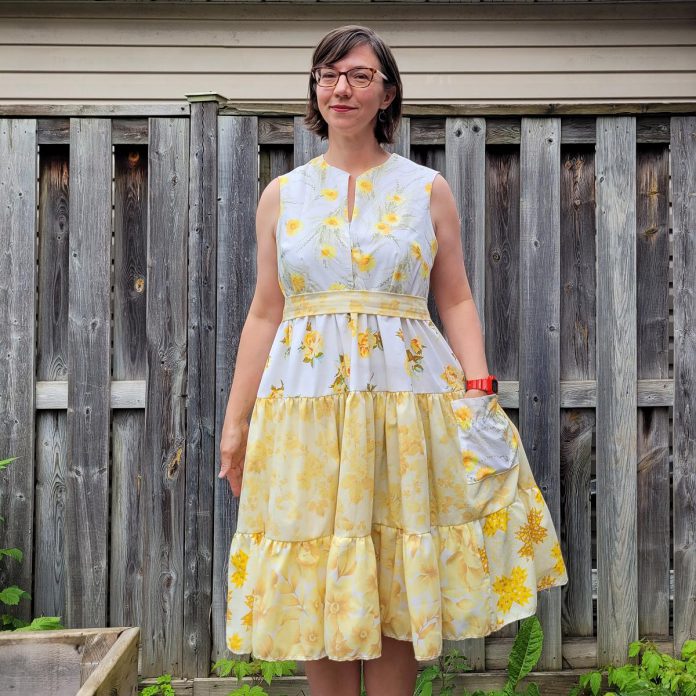
With the rising popularity of thrift stores and consignment shops, conversations around “fast fashion” have been a hot topic in the last few years. And yet, according to Peterborough textile artist Kathryn Bahun, people may not be putting their money where their mouth is when it comes to sustainable clothing.
“If you were to ask someone if they think sustainable fashion is important, they would say ‘yes’, and if you were to ask if they think fast fashion is a bad thing, they would say ‘yes’,” she says. “But then when those same people are out and about shopping, they are often buying fast fashion. I think there’s a disconnect between what we know is important versus what we’re actually doing.”
Bahun has been shopping in thrift stores since long before it became trendy, repurposing clothing, tablecloths, blankets, and anywhere else she can find and turning them into all-new clothing items, mittens, pouches, and tote bags. Her items are sold through her small business Keetarella on Etsy, in store at GreenUp Peterborough and Watson & Lou, and at local vendor markets.
“I just really liked vintage clothing and stuff that I couldn’t find in stores — and it was cheaper too,” Bahun says. “I’d buy stuff that I really liked the look of but didn’t like it as it was.”
Though it began as an expression of her own creativity, it wasn’t until much later that Bahun saw all the environmental benefits to her decision to shop in thrift stores.
According to the UN Alliance for Sustainable Fashion, the world has prioritized “fast fashion” — the term given to the rapid cycle of runway-to-rack clothing items that are poorly produced and low priced — with people are buying 60 per cent more clothing than they did 15 years ago and keeping each item for only half as long.
“I remember stores would get spring clothing and that was it until fall clothing — four months of the same stuff,” she says, explaining that even second-hand stores have changed since then. “Now (thrift stores) are definitely catered towards maximizing the amount of shoppers (they’re) getting in rather than getting as many clothes into this space as possible.”

Today, not only does the fashion industry contribute to exploitative labour practices, including child labour and unsafe working conditions in developing countries, but the environmental impacts continue to grow at a pace similar to that of the changing fashion trends. According to the UN, fashion is the industry consuming the second-to-largest amount of water and is responsible for up to eight per cent of global carbon emissions.
“Clothing, a long time ago, was necessary and now it’s so much more of a want and we use it as a way to deal with a hard day,” says Bahun. “We say ‘I’m going to treat myself, or ‘I’m bored so I’m going to go shopping’.”
With a surge in second-hand and thrift stores over the last decade and the conversations around environmental consciousness, Bahun is hopeful that people are “slowly coming around” to the idea of sustainable fashion. But, she says, there’s always more to be done and education sure helps.
Here are Bahun’s top tips to walk the talk and curate a sustainable closet.
1. Keep the wardrobe you have by finding new ways to wear your pieces
“If you’re really thinking seriously about a sustainable wardrobe, then you’re not going out looking for sustainable clothing all the time,” says Bahun. “The most sustainable thing you could do for your wardrobe is to keep the wardrobe you currently have — no matter where it came from, even if it’s fast fashion.”
Bahun explains that one of the reasons people tend to overconsume when it comes to clothing is because we like to be constantly changing looks and styles. But rather than purchasing something all new, practicing sustainable consumption means livening up your current wardrobe.
“Look into pairing things up in combinations that you hadn’t thought of before,” she suggests. “Take a look at something you want involved in your wardrobe or want to wear more and take the time to try it on with different pieces that you haven’t explored before.”

2. Buy the best quality clothing
When buying clothing (out of necessity, rather than desire), Bahun believes in purchasing the best quality that you’re able to afford.
“If you have the time that you can shop around a little bit, buy something that fits really well,” she says. “Then treat it well so it will last.”
3. Have clothing swaps with friends
“It’s one of my favourite things to do,” Bahun says. “Everyone just gets clothing from their wardrobe that they haven’t worn in a while or they want to change. They swap clothes (and) take something new. There’s no money exchanged, but stuff is going to new homes.”
She adds that this is a good way to hold on to items that you might have a personal or emotional attachment to — and might have the opportunity to borrow back on occasion.
“I know that if a piece is going to a friend who is going to love it and take care of it, then I have an easier time parting with it,” Bahun says.
4. Buy from thrift stores or resellers
While resellers often get a bad reputation for taking low-priced clothing items found in thrift stores and repurposing them for profit, Bahun explains it’s actually beneficial as reselling reduces the amount of clothing that gets left on racks for long periods of time, often ultimately going to the landfill.
“When I look at the racks and racks of clothing, it makes me sick to know that most of that is not going to get purchased by people,” she says. “Resellers are finding the stuff, they’re repairing it, and they’re finding that targeted audience.”
She adds that resellers are a great option for people who don’t have the time to sift through racks in thrift stores looking for a specific item. A reason many people turn to fast fashion is for its ease of access.
“Thrifting can actually take a lot of time and effort and not everyone has that,” Bahun points out. “When you’re buying from a reseller, they’ve done all this work already. It does sometimes cost more, for sure, but you are paying for the fact that someone’s curating a collection of good quality stuff for you.”

5. Learn to do clothing repairs
“There are so many resources on YouTube and sewing is not hard,” Bahun says, joking that she wishes she had the same resources when learning through trial and error. “I know a lot of people are intimidated by it but, once you know the basics, you can do whatever you want.”
If that doesn’t work, or you don’t have the time, Bahun explains it’s easy to find tailors or someone who does repurpose clothing. You can tell them what you like about a piece, and they’ll craft it to suit your desires.
6. Go to Repair Café Peterborough
Bahun is one of many volunteers who will be participating in Repair Café Peterborough at the end of January. The event is a gathering of community members who give their time to help others mend and hem clothing, accessories, footwear, and jewellery. There is also a station dedicated to repairing electronics, and a glue station with various adhesives for repairing a variety of other items.
“Volunteers share their knowledge and help others keep things out of the landfill while trying to bring back the economy of fixing things,” says Caitlin Smith, one of the coordinators of Repair Café Peterborough, which formed in 2014. “Nowadays, it’s harder to find businesses that will actually fix things. Things are made to be obsolete, and it ends up going in the landfill. But more often than not it’s a pretty simple fix.”
The next Repair Café is taking place on Saturday, January 20th from 1 to 4 p.m. at Dreams of Beans (138 Hunter St. W., Peterborough). The group is working on securing a single location to arrange for a “reliable” monthly meet-up. For more information or to become a volunteer, follow Repair Café Peterborough on Facebook or email repaircafeptbo@gmail.com.

7. Reduce overconsumption
Overall, Bahun explains, the number one problem when it comes to fast fashion — both the exploitative nature of it and the environmental consequences — is the human tendency to overconsume.
“If you talk to everyone who was at the mall today and ask, are you buying something that you want or you need, what would be the answer?” she asks, acknowledging that overconsumption is a hard habit to break.
“Ideally that’s the best place to start, but it’s also very unrealistic for a lot of us, unfortunately, so it’s about trying to reduce your consumption when you can.”
For more sustainable clothing made by Bahun, follow Keetarella on Etsy and Instagram.


























